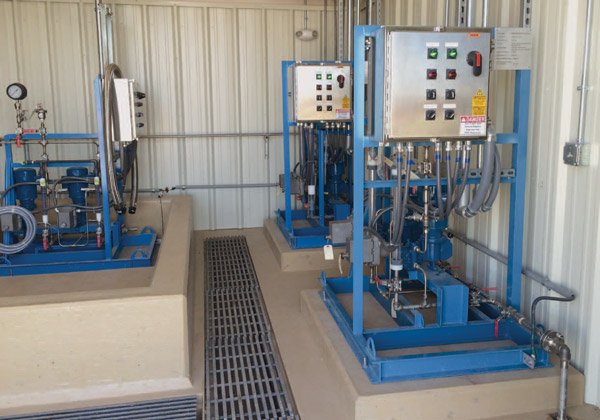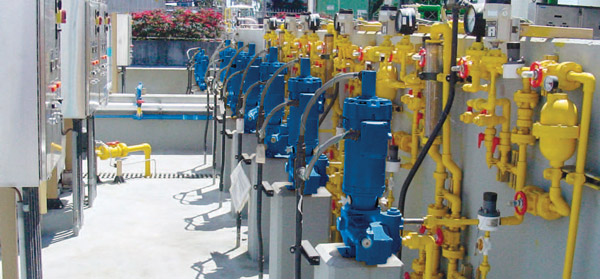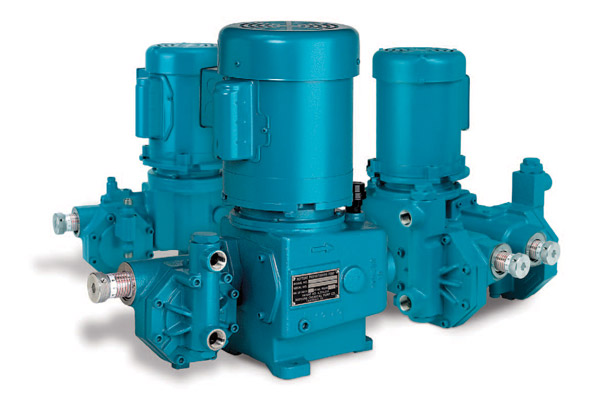Metering pumps have long set the standard in chemical-injection applications, but only if the operator selects a model that addresses all of the operational variables.
A typical water treatment, chemical process or agriculture application can consume large amounts of chemicals during daily operations. While the volumes may be large, they must be very precise, with exact amounts delivered according to strict injection schedules. The pressures that the chemicals are injected at must also be governed precisely, and these can range across a very broad spectrum. This demand for precise flow rates at predetermined schedules and pressures requires the use of a very specific pumping technology that can ensure successful, reliable adherence to the injection schedule and fluid volumes.

Today, as modern metering pump technology can be easily set to deliver exact volumes according to a set schedule, and at various pressures, metering pumps have become the trend for the purposes of chemical injections in water treatment, processing and agricultural applications. However, there are many different styles and modes of operation within the realm of metering pumps. This article will explain the different metering pump technologies and demonstrate how the user should select the proper size and style depending on the injection application for which the pump will be tasked.
Know the Variables
When determining the most suitable metering pump for a chemical-injection application, there are multiple variables that must be factored into consideration, including:
Flow Rate
Metering pumps should never be oversized, meaning that determining the exact flow rate that is required for the application in question is of paramount importance. With this in mind, a metering pump should be sized so that the maximum expected flow rate is 85% to 90% of the pump’s capacity, which will leave room for additional capacity, if needed.

Materials of Construction
Metering pumps are available in a variety of materials, most commonly 316 stainless steel, C-20 stainless steel, PVC and Kynar® PVDF. When selecting a metering pump’s materials of construction, the corrosion, erosion and solvent action of the chemical must be taken into consideration. For example, solvent-based chemicals may dissolve plastic-headed pumps, while acids and caustics may require stainless-steel models. The effects of erosion must also be considered when the chemical takes the form of abrasive slurry.
Chemical Composition
Chemicals come in many formulations, from extremely thin to highly viscous, while they can also be classified as a slurry or off-gas when transferred. Standard metering pumps are typically able to handle clear liquids with viscosities ranging from water-like to 1,500 cPs. Chemicals with viscosities that approach 5,000 cPs or have light suspensions will require special liquid ends. Those with viscosities up to 20,000 cPs or that contain up to 10% solids will require special diaphragms, while ones that automatically vent accumulated gas will need their own variety of liquid ends.
Driver
Drivers, which can be powered by electricity, water, gas, air or the sun, must be selected according to the utilities that are available. Driver selection must also take into account any environmental hazards that may be found in the operating area, with the operator realising that pumps used in remote locations may not be able to be inspected as often as those in controlled environments.
Environment
Determine if the pump will be operating indoors or outdoors. If used outdoors, the pump must be sheltered from direct sunlight. Any pumps that will be used in freezing temperatures can only pump fluids that will not freeze at that temperature.
Method of Control
The operator must know how the pump will be used, either manual continuous operation, on/off operation of operation that is governed by a process signal.
When all is said and done, method of control may be the most important variable when choosing a metering pump, so let’s take a closer look.
Many styles of metering pumps allow flow rates to be adjusted manually through the use of a micrometre dial. Adjusting this dial changes the pump’s stroke length and allows the pump to be operated anywhere between 10% and 100% of its rated flow capacity. Metering pumps with micrometre dials may also feature a variable speed drive that allows adjustment of the pump’s stroke speed. Utilising the two in unison can allow additional adjustability or turndown capabilities over the range of the drive, depending on the pump’s stroking speed. For example, a pump operating at 75 strokes per minute (spm) would produce a 5:1 turndown ratio on speed with the variable speed drive and a 10:1 turndown ratio on stroke length via the micrometre dial.
Flow rates can also be controlled automatically by a process signal and through the implementation of electric or pneumatic positioners that can adjust the stroke length, which will deliver a full 10:1 turndown ratio. In this method of control, the number of doses will remain constant with the size of each dose reduced, resulting in doses that are uniformly distributed in a constantly flowing line.
Metering pumps that use a variable speed drive will deliver a turndown ratio that is determined by dividing the pump’s stroke speed by its minimum operating speed. A variable speed drive will enable the pump to inject a dose of the same size on each stroke, but since the stroke speeds will change, the doses themselves will be less frequent. Additionally, it is not practical to use a variable speed drive on motor-driven pumps that normally operate at speeds less than 100 to 150 spm, since slowing the motor causes each stroke to take longer to complete from start to finish. However, electronic metering pumps, which are pulsed by a solenoid, can operate at less than one spm because the timing of each stroke from start to finish is uniform at every stroking speed.

Planning a Metering Pump Installation
Now that all of the variables have been identified and reviewed, it is time to design the pumping system, keeping in mind any location or environmental concerns that may be present. For best results, the system’s design should originate from the liquid source or feed tank and work its way to the injection point, while keeping in mind that metering pumps will be able to “push” against great pressures but will struggle to “pull” over longer distances.
This means that suction lift should be limited to no more than four feet (1.2 metres) and that a foot valve should be used in top-mount installations. Flooded suction is always preferred in a metering pump installation as it makes the pump easier to prime, although the length of the flooded suction should be limited to six or seven feet (1.8 to 2.1 metres). Also, as with all pump installations, adequately sized lines should be used and piping runs should have minimal bends, elbows or other design characteristics that may restrict or limit flow.
Other components of the installation to consider include:
Suction Piping
The traditional rule of thumb is to use suction piping that is one size larger than the pump’s suction connection, though it is acceptable to use piping that is the same size as the suction connection if the metering pump will be operating at a slow speed when transferring low-viscosity chemicals. Generally, do not use hard piping that is smaller than 1/2” in diameter or that is smaller than 3/8” in diameter for low-flow applications that use plastic tubing.
Discharge Piping
The size of discharge piping is not as critical as that of suction piping, but the piping must be suitable for the discharge pressure. Typically, matching the pipe size to the discharge connection should be sufficient to ensure proper and reliable operation.
Suction Strainer
A suction strainer should always be used as it will prevent foreign matter from entering the pump’s ball checks.
Flanges/Unions/Compression Fittings
At least one of these must be installed at the pump’s suction and discharge ports in order to facilitate maintenance procedures more easily.
Isolation Valves
Large-port, quick-opening isolation valves should be placed at both the suction and discharge ends of the installation as a way to ease maintenance operations. Ball valves are usually the best choice for this operation, while needle valves should not be used because their design will cause the creation of a flow restriction.
Calibration Column
As metering pumps very often feature pulsed flow at low volumes, a draw-down calibration column is the most accurate and convenient method to measure pump performance, provided that the liquid in the column draws down smoothly and stops precisely at the end of each suction stroke. A tall, thin column should be used to ensure ease of reading and reporting accuracy. Calibration columns can also be helpful in determining if any wear has occurred or dirt has accumulated in the pump’s check valves; if the liquid in the column “bounces,” that may indicate that the valves are worn or dirty.
Relief Valve
Though the metering pump may be constructed with an internal relief valve, it is recommended that an external relief valve also be installed. The external relief valve should be set at 50 psi (3.5 bar) or 10% above the maximum operating pressure, whichever is greater. Any chemical that flows through the relief valve is piped back to the feed tank. Using transparent tubing for the relief valve will allow the operator to observe any returned fluid and identify any impurities. When piping the relief valve’s return to the suction side of the installation, the return must be upstream of the pump’s isolation valve so that the flow rate will not become blocked.
Back-Pressure Valve
This component is only necessary when the installation does not produce adequate back pressure and the pump does not contain a built-in back-pressure device. Back-pressure valves are also required when a system has a low-pressure injection point that is hydraulically lower than the feed tank.
Pressure Gauge
If this optional device is installed, a diaphragm seal must be used if the pump is to be transferring chemicals that are corrosive to stainless-steel gauge parts, or are viscous or contain particles that could clog the Bourdon tube within the gauge. The pressure gauge should be sized 30% to 50% larger than the maximum expected pressure that is produced by the system.
Pulsation Dampener
Pulsation dampeners are most commonly required in systems that feature long discharge lines where fluid acceleration during the pumping process can adversely affect the pump’s maximum pressure capacity or relief-valve setting. The pulsation dampener will minimise the pressure spikes that may be caused under these acceleration circumstances and, in the case of high-volume pumps, reduce piping harmonics.
Injection Quills/Check Valves
An injection quill that is installed at the pump’s injection pump will serve as a check valve while providing better dispersion of the chemical. In low-pressure applications, an injection quill that incorporates a corporation stop, which allows the injection quill to be inserted or removed without having to drain or shutdown the system, will improve efficiency and overall performance.
Conclusion
In process or agricultural applications where precise, reliable, efficient injection of chemicals is critical to optimising performance, metering pumps have been proven over the years to deliver the required method of operation. However, knowing that requiring a metering pump is not nearly enough to ensure that the best pump will be chosen for the job. A long list of important variables must be considered, along with an array of pump components that will help optimise performance, if deployed appropriately. Successful chemical injection via metering pump will only be achieved if all variables are taken into consideration and system installation adheres to suggested protocols.
About the Author
Tom O ’Donnell is Director of Business Development for Neptune™ Chemical Pump Company and PSG®. Based in North Wales, PA , USA, Neptune is a leading brand of chemical metering and peristaltic (hose) pumps, chemical feed systems, chemical injection accessories, polymer make-down systems and industrial mixers. Neptune is part of PSG®, a Dover company, Oakbrook Terrace, IL, USA. PSG is comprised of several leading pump brands, including Abaque®, Almatec®, Blackmer®, Ebsray®, Griswold™, Maag Industrial Pumps, Mouvex®, Neptune™, Quattroflow™, RedScrew™ and Wilden®.